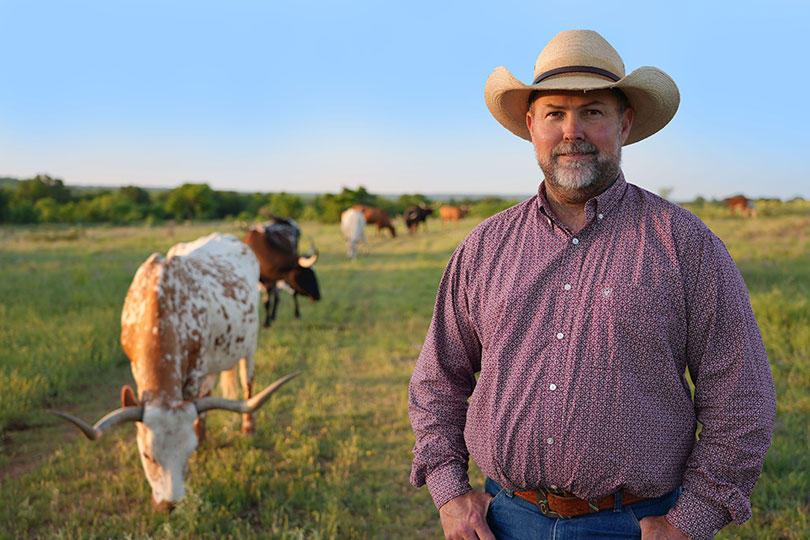By Emmy Powell
Communications Specialist
Since the early 1700s, the spirit and tradition of the Lone Star State have been recognized in one iconic animal—the Texas Longhorn.
The Longhorn is a living symbol of the state’s rugged history and resilience.
“Texas Longhorns are the original cattle of Texas,” Will Cradduck, herd manager for the Official State of Texas Longhorn Herd, said. “They were here in Texas before this area was settled. They were introduced by the Spanish in the 1500s and were the first and only cattle for about 350 years.”
After the Civil War, ranchers drove millions of Longhorns up the cattle trails to Kansas. Their endurance was well-suited for the journey.
“The Longhorns were probably the only cattle in the world at the time that could have made that trip successful, and they did by the millions,” he said.
Bult to survive
Early settlers saw Longhorns as wild game—tough, fast and nearly impossible to hunt. But those traits are exactly what helped the breed survive.
“Longhorns can walk 10 or 15 miles a day with the normal grazing pattern,” Cradduck said. “They don’t get hot. They don’t overheat, and they can eat just about anything that grows. So, they can adapt to about any forage on the trail.”
Their Spanish origins equipped them for the Texas climate.
“They lived in the Spanish Peninsula, a mediterranean climate, with hot, dry summers, mild winters and isolated from all the other cattle in Europe by mountain range,” Cradduck said.
According to the Cattlemen’s Texas Longhorn Registry, Longhorns are recognized as the only breed to evolve without human intervention, and DNA testing confirms the state herd’s lineage is purely Spanish.
“We know that there’s not any other breed influence in these cattle. It’s almost like looking back in time when you look at these cattle,” he said.

Roaming wild to the cattle trail
By the late 1880s, the population had grown, and there were millions of Longhorns across the Lone Star State, Cradduck noted. Cowboys transformed the wild longhorns into trail-broke cattle.
“Cattle were worth a lot more in Kansas than they were here,” he said. “So, that was the start of the trail drives out of Texas. Local ranchers figured out quick that the cattle they had were suddenly worth about five times as much as they were before.”
Nearly 10 million cattle were driven north to market between 1867 and 1880.
Preserving the Longhorn legacy
By the 1900s, demand for Longhorns declined. But in the 1920s, Western writer J. Frank Dobie and others stepped in to preserve the iconic breed.
Dobie, businessman Sid Richardson and rancher Graves Peeler organized a herd and donated them to the Texas Parks Board in 1941 as the state herd.
“Through his efforts and some others, the state herd was established to help preserve that piece of history,” Cradduck said.
The cattle received the designation as the Official State of Texas Longhorn Herd in 1969.
“This herd is a historic herd that’s been around since 1938,” Cradduck said. “It was put together for two reasons: to show people what historic Texas Longhorn cattle look like and to help preserve the breed for many years to come.”
The herd now consists of about 250 cattle and resides primarily at the Fort Griffin State Historic Site and San Angelo State Park. A few head reside at Copper Breaks State Park, Lyndon B. Johnson State Park and Palo Duro Canyon State Park.
Herd genetics
The legacy of the breed is in the genetics.
“We’re talking about genetically managing a herd that holds a large portion of its the entire breed’s remaining genetics in the world,” said Cradduck, who has been managing the Fort Griffin herd for 16 years. “It’s kind of a big deal. We think there’s only a few thousand of this kind of Longhorn left in the world that are genetically pure, historically correct Texas Longhorns.”
The herd is mostly closed, but he noted they occasionally bring in bulls from the Texas Longhorn Breeders Association of America.
Visit the herd
Fort Griffin State Historic Site was selected as the herd’s permanent home in 1948, and the herd is managed by the Texas Historical Commission. Texans and travelers can see the historic herd and learn more about their role in Texas history.
Tours offer a glimpse into the past and the perseverance of a breed that helped shape the Lone Star State.
For more information, visit thc.texas.gov.


Leave A Comment